Growing Swiss Chard in July UK: Your Complete Summer Sowing Guide
July is the perfect time for a second sowing of Swiss chard in the UK. Discover how to grow this colourful, nutritious vegetable for autumn harvests and early spring pickings, plus the best varieties to choose for your summer garden.
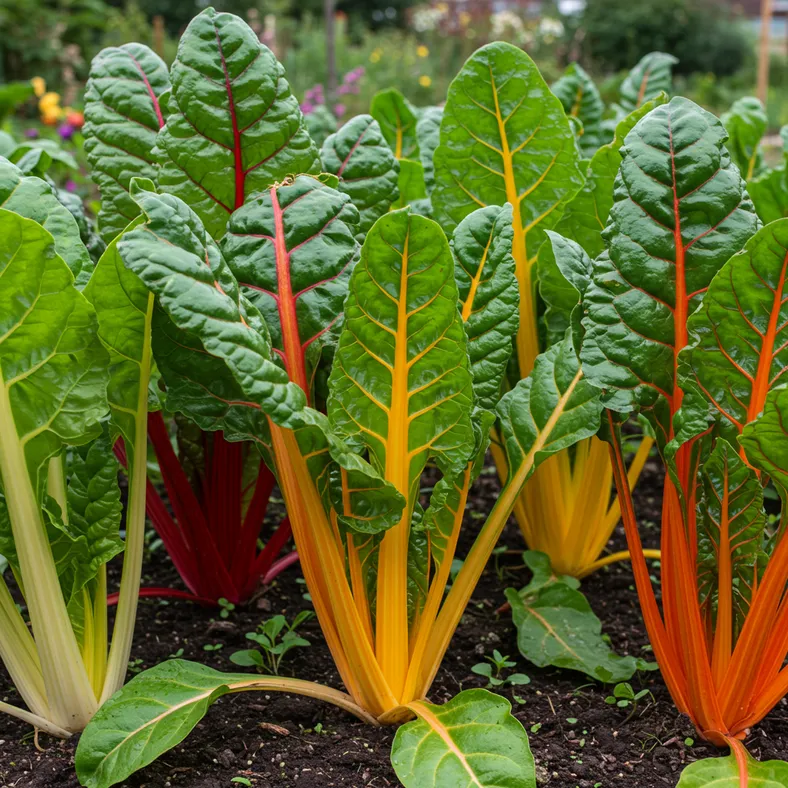
- Why July is Perfect for Swiss Chard Sowing
- Choosing the Best Swiss Chard Varieties for Summer Sowing
- Soil Preparation and Site Selection
- Direct Sowing Techniques for July Success
- Germination and Early Seedling Care
- Summer Care and Maintenance
- Harvesting Your July-Sown Swiss Chard
- Overwintering and Spring Harvests
July marks a crucial window for Swiss chard cultivation in the UK, offering gardeners the opportunity to establish a second crop that will provide abundant harvests through autumn and even into the following spring. This versatile leafy vegetable, also known as perpetual spinach or leaf beet, thrives in our summer conditions and brings both exceptional nutrition and stunning ornamental appeal to any garden.
Swiss chard's rainbow of coloured stems - from deep ruby red to sunshine yellow and pristine white - makes it as beautiful as it is productive. Unlike many vegetables that struggle in summer heat, chard actually benefits from July sowing, establishing strong root systems that will carry plants through winter for early spring harvests when fresh greens are most precious.
Why July is Perfect for Swiss Chard Sowing
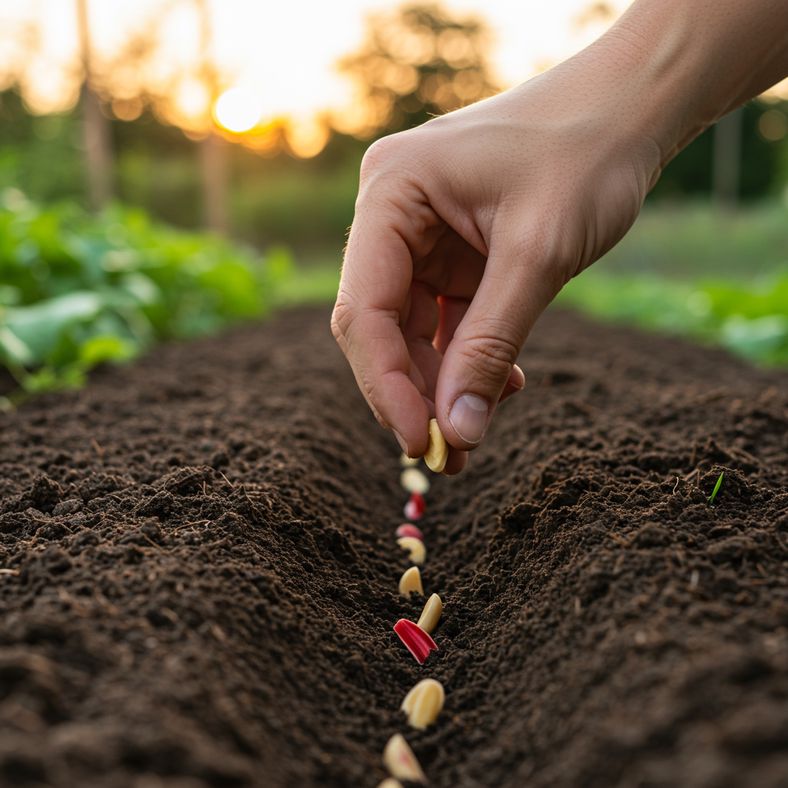
July presents ideal conditions for establishing Swiss chard in UK gardens. The warm soil temperatures - typically 15-20°C - encourage rapid germination, whilst the longer daylight hours provide ample energy for vigorous early growth. This timing strategy offers several distinct advantages over spring sowings.
Most importantly, July-sown chard will mature during the cooler autumn months when the leaves develop their best flavour and texture. The plants establish robust root systems during summer's warmth, enabling them to withstand winter frosts and provide valuable early harvests the following spring when shop-bought greens are expensive and often lacking in freshness.
Additionally, July sowing allows you to fill gaps left by harvested early crops like broad beans or early potatoes, maximising your garden's productivity throughout the growing season. The cooler autumn growing conditions also reduce the likelihood of bolting, ensuring a longer harvest period.
Choosing the Best Swiss Chard Varieties for Summer Sowing

Selecting the right variety is crucial for July sowings, as different cultivars offer varying levels of hardiness and visual appeal. 'Bright Lights' remains the most popular choice, offering a spectacular rainbow of stem colours including red, yellow, orange, pink, and white - perfect for creating an ornamental edible display.
For maximum reliability and winter hardiness, white-stemmed varieties like 'Fordhook Giant' excel in cooler regions. The pure white ribs contrast beautifully with dark green leaves and tend to be the most productive and cold-tolerant options available.
Red-stemmed varieties such as 'Rhubarb Chard' or 'Charlotte' provide stunning visual impact with their deep crimson stalks and red-veined leaves, though they may be slightly less hardy than white varieties. These are ideal if you're growing chard as much for ornamental appeal as culinary use.
For those seeking a reliable source of quality seeds, Swiss Chard 'White Silver' Seeds offer excellent germination rates and proven performance in UK conditions.
Disclaimer: This article contains Amazon affiliate links. We may earn a small commission from qualifying purchases at no additional cost to you.
Soil Preparation and Site Selection

Swiss chard thrives in rich, moisture-retentive yet well-draining soil with a pH between 6.0-7.0. Begin preparation at least a week before sowing by removing all weeds and incorporating generous amounts of well-rotted compost or aged manure into the top 20cm of soil.
Choose a location that receives full sun to partial shade - chard actually appreciates some afternoon shade during hot summer periods, making it more tolerant than many vegetables of slightly shadier spots. Avoid waterlogged areas, as chard roots are susceptible to rot in persistently wet conditions.
The ideal site should be sheltered from strong winds which can damage the large leaves, whilst still allowing good air circulation to prevent fungal diseases. If your soil is heavy clay, consider creating raised beds or adding sharp sand and organic matter to improve drainage.
For container growing, choose pots at least 40cm wide and deep, filled with high-quality, peat-free multipurpose compost. This allows for proper root development and easier harvesting throughout the growing season.
Direct Sowing Techniques for July Success
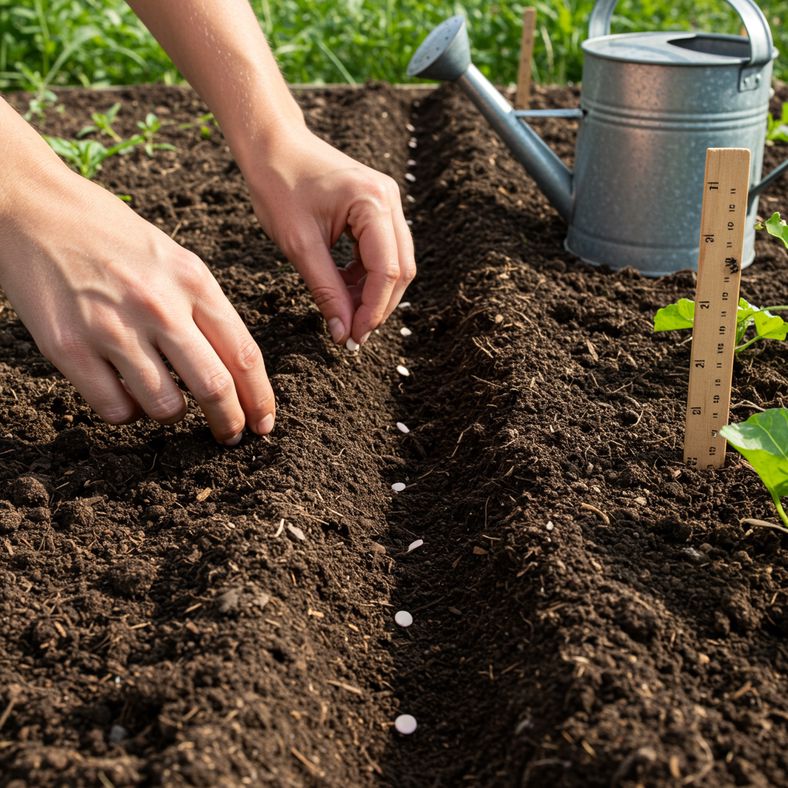
July's warm soil conditions make direct sowing the preferred method for establishing Swiss chard. Begin by creating straight drills 2.5cm deep using a hoe or dibber, spacing multiple rows 45cm apart to allow for the plants' eventual spread.
Water the drill thoroughly before sowing - this ensures immediate moisture contact with seeds and prevents them washing away during subsequent watering. Space the large, corky seeds 10cm apart along the drill length, then cover with fine soil and firm gently.
Unlike smaller seeds, chard's substantial size makes precise spacing straightforward, reducing the need for extensive thinning later. After covering, water gently using a fine rose to avoid disturbing the seeds, and maintain consistent moisture throughout the 7-14 day germination period.
For continuous harvests, consider making additional sowings every 3-4 weeks through August, though July remains optimal for overwintering crops. Mark your rows clearly, as germination can be uneven and you'll want to distinguish chard seedlings from weeds.
Germination and Early Seedling Care
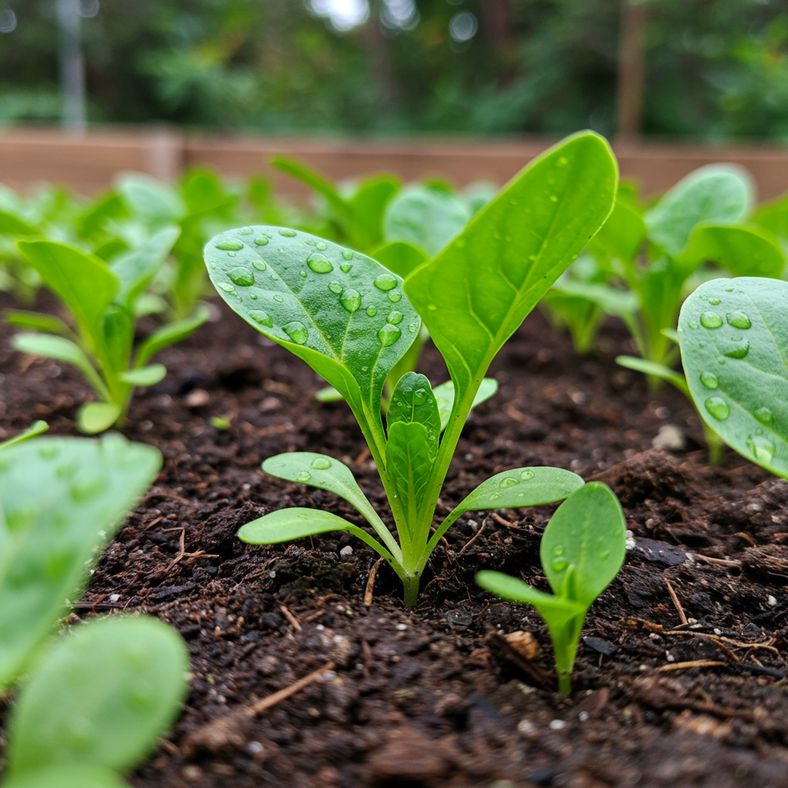
Swiss chard typically germinates within 7-14 days in July's warm conditions, with the large seeds providing substantial energy reserves for vigorous early growth. Monitor soil moisture carefully during this critical period, as the surface can dry rapidly in summer heat.
Once seedlings emerge with their first true leaves, begin a gradual thinning process. Remove the weakest plants first, leaving the strongest specimens at 30cm intervals for full-sized plants, or 5cm apart if you plan to harvest as baby salad leaves.
Protect young seedlings from slugs and snails, which are particularly active in warm, moist conditions. Create barriers using copper tape, diatomaceous earth, or beer traps positioned around the growing area. Hand-picking during evening inspections often proves most effective.
Young plants benefit from weekly feeding with diluted liquid fertiliser to encourage rapid establishment. A balanced feed with equal nitrogen, phosphorus, and potassium ratios supports both leaf development and root growth during this crucial phase.
Summer Care and Maintenance

Once established, Swiss chard requires minimal maintenance, though consistent care ensures optimal leaf production. Water deeply but infrequently, encouraging roots to penetrate deeper into the soil where they'll find more consistent moisture reserves.
Apply a thick mulch of garden compost or well-rotted manure around plants once they reach 10cm height, leaving a 5cm gap around each stem base to prevent rot. This conserves moisture, suppresses weeds, and provides a slow-release nutrient source throughout the growing season.
Remove any flower spikes immediately they appear, as bolting redirects energy from leaf production. In very hot weather, temporary shade cloth can prevent stress and maintain leaf quality, though this is rarely necessary in the UK climate.
Weekly inspection for pest damage allows early intervention before problems establish. Remove any damaged or yellowing leaves promptly to maintain plant health and prevent disease spread.
For gardeners looking to expand their summer growing repertoire, consider companion planting with Little Gem Lettuce Seeds for a diverse salad harvest, or Garden Turnip Purple Top White Globe Seeds for root vegetables that mature alongside your chard crop.
Harvesting Your July-Sown Swiss Chard
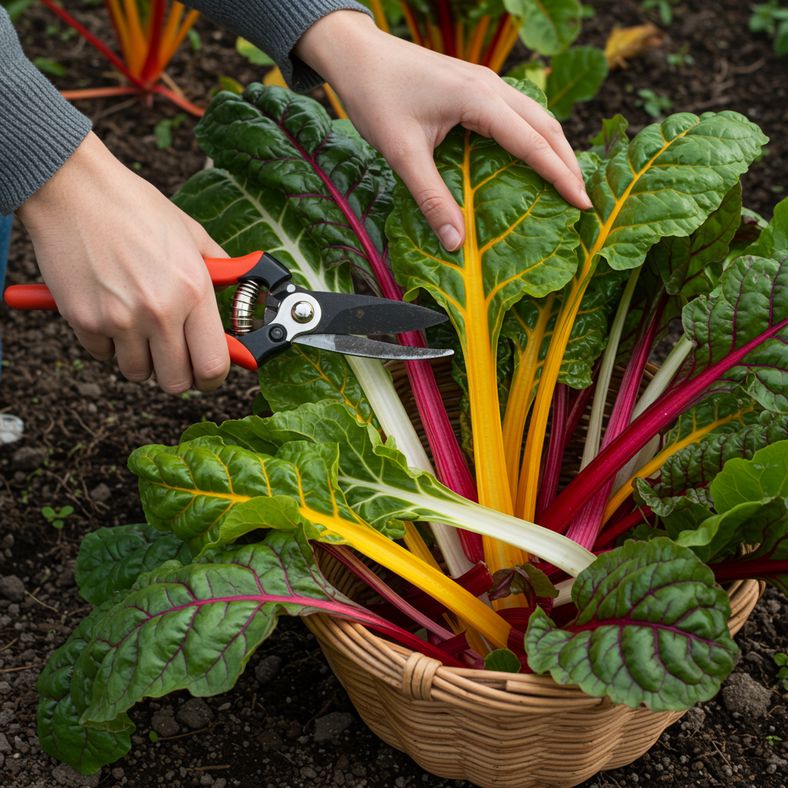
July-sown Swiss chard typically reaches harvest size by September, providing fresh leaves throughout autumn and into winter. Begin harvesting when plants reach 15-20cm height, taking outer leaves first whilst leaving the growing centre intact for continued production.
Use sharp secateurs or scissors to cut stems cleanly at the base, avoiding damage to surrounding leaves. For maximum yield, harvest regularly - taking 3-4 outer leaves per plant every 7-10 days encourages continuous new growth and prevents leaves becoming tough or bitter.
Young leaves up to 10cm long can be eaten raw in salads, offering a mild, slightly earthy flavour with attractive colour contrast. Larger leaves excel when lightly steamed, stir-fried, or added to soups and pasta dishes, with the coloured stems providing both flavour and visual appeal.
During winter months, growth slows significantly, but plants remain productive in mild spells. Protect with cloches or fleece during severe weather to maintain quality and encourage spring regrowth when fresh vegetables are most valuable.
The stems deserve special attention - white varieties offer a mild, celery-like crunch, whilst coloured stems tend to be slightly sweeter. Cook stems separately for 2-3 minutes longer than leaves to achieve optimal texture.
Overwintering and Spring Harvests
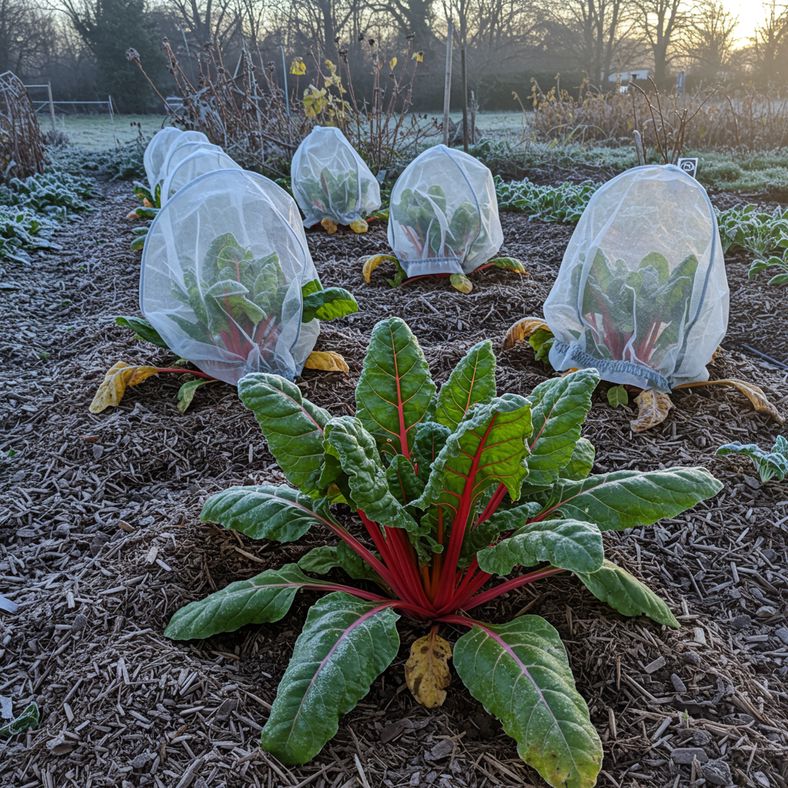
One of July sowing's greatest advantages is producing plants robust enough to survive UK winters outdoors. Well-established chard plants withstand temperatures down to -10°C, though growth virtually stops during the coldest months.
Prepare plants for winter by removing any damaged or yellowing leaves in late autumn, and applying a thick mulch layer to protect root systems from freeze-thaw cycles. In exposed locations, temporary windbreaks help prevent wind damage to remaining foliage.
Growth resumes rapidly as temperatures rise in early spring, often providing harvests 4-6 weeks before newly sown crops. These early leaves are particularly tender and sweet, commanding premium prices in shops whilst your plants provide them free.
Monitor plants closely as growth resumes - the combination of warming weather and lengthening days triggers rapid development, and regular harvesting becomes essential to maintain leaf quality. Most overwintered plants will provide good harvests through late spring before eventually running to seed.
For those planning next year's garden, now is an excellent time to order Garden Spinach Beet Perpetual Seeds for a similar overwintering crop with slightly different flavour characteristics.